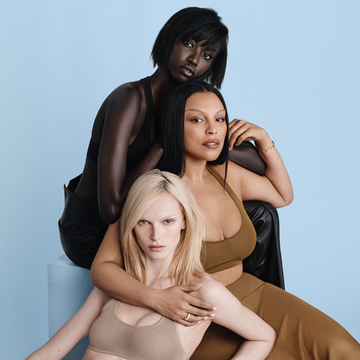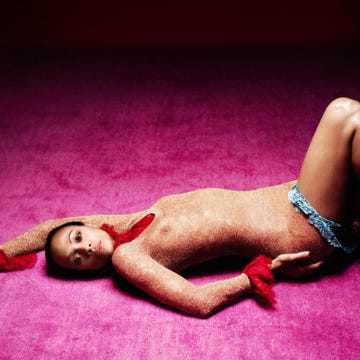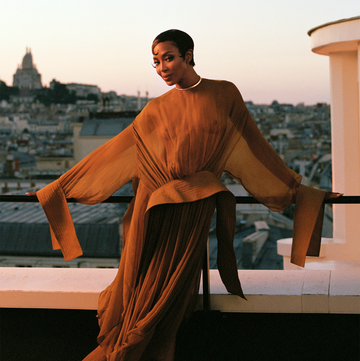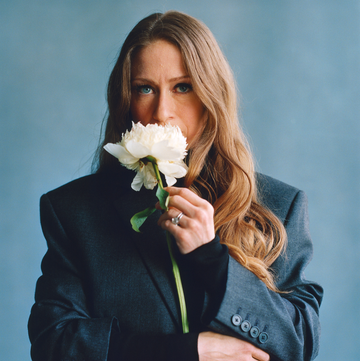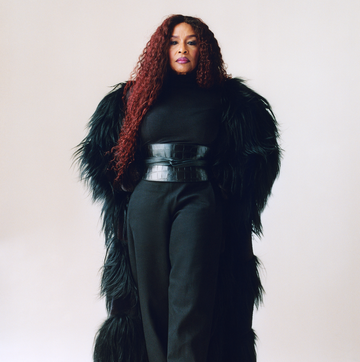Linda Evangelista lifts her shirt over her head. She wants to show me her scars, two purple, ragged parentheses that travel from her outer breasts to her mid back, just under the shoulder blades. I have to muffle a gasp. They look violent, like coordinated shark attacks or swipes from the grim reaper’s scythe. She rearranges her black T-shirt, straightens her aviator glasses, tucking her bob behind her ears, and smiles as if to say, “Yes, I lived through that.”
The double mastectomy, followed by the removal of a lump between her breasts: lived through that. Liposuction and surgery over and over again—four times under her chin alone—to extract the hunks of hardened fat caused by CoolSculpting machines. Collapsed lungs. So many collapsed lungs. She lived through all of it. Sorry, grim reaper, but you picked the wrong girl.
Now, as she nears her 60th birthday, Evangelista is smiling. Glowing even. She’s ready to get on with living, putting the damage and the scars behind her.
Well, maybe not behind her exactly, because she seems proud of those marks. I mean, you don’t take off your shirt because you’re timid or ashamed. “My double mastectomy, I’m fine with it,” she tells me. “I did put in very small implants. What they took out, I put in, cc-wise. I’ve had all those lung surgeries, oh my God, and my keloids and all the chest-tube scars and my C-section scar. There were a lot of surgeries. I’m cool. I’m fine with those. I won. I’m here. I won.”
It’s a life of winning if you choose to see it that way. Not many people would—unless they consider the alternative. Which she does.
Evangelista’s winning streak started early, thanks to a harmonious arrangement of eyes, nose, and mouth, a bright, blazing smile, a long, graceful neck, and an impeccable line from ankle to hip. This is someone who can stick two fingers in her mouth and whistle as if it were the most elegant gesture known to mankind. I remember that whistling picture; it’s a killer.
She paired her easy beauty with an uncommon work ethic. She was an athlete, in complete control of every muscle, a racehorse that couldn’t wait to run.
Early in her career, when things weren’t exactly singing, she had the good fortune of meeting Steven Meisel, who operated a sort of beauty lab out of his photography studio on 23rd Street in Manhattan. He’d take girls fresh off the boat or the bus from their various hometowns (near the Canadian side of Niagara Falls, in Evangelista’s case) and transform them, inch by exacting inch. “Steven would tell her, ‘Move your foot just a little bit. Point your ankle to the left and your knee to the right,’ ” remembers Paul Cavaco, the fashion director (with a memorable tenure at this magazine) who collaborated with Meisel and Evangelista from the beginning. “And she could do it! You don’t think of modeling as mastery, but it is. You believed the picture, even if it was over-the-top. She would make the face, she would scream. She didn’t care if she looked ugly. And she always looked beautiful.”
If Cindy was the practical beauty, turning her work into a commercial enterprise, and Naomi was the Amazonian beauty, explosive and powerful, and Christy was the doe-eyed beauty, joyful and warm, Linda was the purist, the Platonic ideal of a model. As the hairstylist Garren, who also participated in those Meisel sessions, says, “Her whole world was built on the way she looked. She couldn’t act, she couldn’t sing. She could play the accordion. But she said, ‘Who wants to hear the accordion?’ ”
Well, some people did. She held her accordion as if she was a Fellini star in photographs by Peter Lindbergh, Arthur Elgort, and Ellen von Unwerth and on The Tonight Show. But really, she was made for the camera. “I loved working,” she says. “You never heard me complain about my job, never. I thought it was the greatest job in the world.”
As everyone knows, she didn’t get out of bed for less than $10,000 a day. It was a statement she came to regret for its arrogance. I see it as a declaration of worth. Is it so offensive to know your value? Evangelista considers that. “There’s different ways of saying ‘I value myself, and I command this for my services because I’m worth it’ than the way I said it.”
Besides, I know for a fact that she got out of bed for a lot less than 10 grand. Editorial work paid $250 a day then, and for designers she loved—Anna Sui, Marc Jacobs—she’d waive her fee in exchange for clothes. Still, the quote lives on as modeling’s “Let them eat cake.”
Evangelista’s value was practically tangible. She had the ability to ignite desire for the clothes on her back. If she wore it, editors scrambled to shoot it and retailers rushed to sell it, something Karl Lagerfeld and Gianni Versace recognized. Who do you picture when you play George Michael’s “Freedom! ’90” video in your head? Correct: the model with the platinum hair, cocooned in a turtleneck.
If Evangelista appeared on the cover of a magazine, she could help transform its identity and draw advertisers and readers to its pages. She famously ushered in the “era of elegance” on Liz Tilberis’s inaugural issue of Harper’s Bazaar in September 1992 and helped re-establish it as a wildly stylish force. When she appeared on the cover of Allure in June 1991, I was the lucky beneficiary of her star power. As I recall, we had all of seven pages of advertising at the time. (For the uninitiated, that was about 100 pages too few.) Platinum-haired Evangelista helped change our fate.
In those flush, big-money days, we’d crowd into the tiny elevators at the Ritz in Paris in the wee hours—Evangelista, Madonna, Kate Moss, and Sharon Stone’s bodyguard. We’d gather in the lobby of the Four Seasons in Milan, charging cocktails to the room before the Versace show started down the street. I have a picture of Evangelista there, crouching next to a bald, barefoot baby, my son. He’s 30 now, which means Evangelista and I have also logged all those decades.
During the supermodel reign of the 1990s, Evangelista became an avatar of beauty, possessing all of its power. And yet, she says, “I didn’t walk around thinking I was beautiful. The attention was for the work, not for the person. I was never told I was beautiful. I was told, ‘Oh, your hair looks great.’ Or ‘The foot is working. The foot is good.’ But no one ever said, ‘Linda, you’re beautiful.’ ”
She now tells everyone she can what she never heard herself, as if to right a wrong. “I make a point … I tell my nephews, I tell my friends, and I especially tell my son how beautiful he is because I think it’s important to hear it.”
There’s that word again. Is beauty love? Is it benevolence? The riches of life are deposited at the feet of the beautiful. Their facial symmetry blurs into ethical issues, with beautiful people believed to possess greater kindness, goodness, success, and sociability than the unlovely. It’s not fair, but then again, intelligence, creativity, athleticism—none of these attributes are distributed evenly or fairly.
“In our culture and our society, people behave very strangely around beauty,” says Christy Turlington Burns, who knows of what she speaks. “Women don’t like you if you’re very beautiful.” That’s why she’s grateful for the leveling of age, even though Turlington Burns’s 56 is surely not mine. “Getting older takes the edge off. The older I get and the more distance I have from that, the freer I feel. As I get older and don’t get looked at, I’m happy. The male gaze is suffocating.”
Evangelista echoes that feeling. For years, she says, “I felt like the eyes were on me. I don’t feel them on me any longer. And I’m fine with that. That wasn’t sustainable, whatever that was back in the heyday, and I’m sure glad I’m not living that life.”
After what she’s been through, Evangelista is reassessing the whole concept of beauty. “I really think beauty is something you earn. I think of my grandmothers’ faces and what the war did to them, the toll it took on them … just wearing their hardships. They wore it, and they were so gorgeous. It had nothing to do with perfection or youth.” At this, she starts to cry, and I ask if she’s okay. She demurs, saying the tears are happy ones.
Evangelista wears a different kind of hardship on her body, and it’s something that’s been a challenge to reconcile: wanting to hold on to beauty, to do what it takes, including technical interventions like freezing your fat, and then suffering the unexpected consequences of those choices.
Garren styled Evangelista’s hair for the 2022 People magazine shoot where she spoke publicly about the damages she had endured from CoolSculpting treatments. He saw for himself the hardened fat around her abdomen, between her thighs, and under each armpit. “I was in shock,” he says.
It’s hard to imagine. It’s unimaginable. For someone whose beauty was her career and her identity, now “I have to go through therapy to like what I see when I look in the mirror, and I still don’t look in the mirror. I didn’t want to see myself because I didn’t love myself or like myself.”
Aging well—if there is such a thing—is a tightwire act: Love yourself, but endure the pain. Don’t let yourself go, but don’t go too far. Exercise all your power, but never let the effort show. Keep up the Botox injections, but dissolve the filler, as Evangelista did, because, she says, “I wasn’t looking like me.”
And what does anyone look like anyway? The aging process plays many dirty tricks, not least of which is the one that we can, with the right technology, push against its inevitable creep. There’s Facetune and filters on social media, filler and Botox you can re-up on your lunch break. A face lift is no longer the domain of sexagenarians but a considered option for anyone with enough money and courage—or perhaps fearfulness. Is 70 the new 40, or has it become a distorted non-age? Does anyone look old anymore?
Yet while beauty interventions advance, body horror may be an extreme side effect, as The Substance makes all too flat-footedly clear. Evangelista thinks a lot about its predecessor, the 1992 movie Death Becomes Her. “I used to ask myself all the time, ‘Would you drink the magic potion knowing it comes with these repercussions?’ Obviously, no, because you saw the repercussions. But if there were no repercussions, of course you’d drink the magic potion if you could afford it, and it’s there for you, and other people have used it successfully.”
Evangelista drank the potions, and now she’s trying the antidotes. “I’m doing the work, and I’m trying to get to the place where I like myself, flaws and all, and trying to love myself.”
She’s beginning to find some peace, and maybe that, too, is an upside of aging. “I don’t care how I age. I just want to age. It doesn’t have to be gracefully. I really, really, really don’t want to die. I have still so much to do. I’m finally getting comfortable with myself and with everything, and now I want to enjoy it.”
Her son, Augustin—she calls him Augie—is starting college in a few months. “I want to be a grandmother, but not in the immediate future,” she says. That’s her way of saying she wants to keep going, to grow old, to accept some, if not all, of the wrinkles.
“I’m alive. I’m alive. I’m alive, and I’m going to do what I have to do. I’m going to fight because I don’t want it any other way. I’m not done.”
This article appears in the May issue of Harper’s Bazaar.
Opening Image: Suit, Giorgio Armani. Elsa Peretti Feather necklace, Tiffany & Co.
Hair: Mustafa Yanaz for Bumble and Bumble; makeup: Dick Page; manicure: Leonobi Galvez Ortiz; casting: Anita Bitton at the Establishment; production: Rosco Production.













